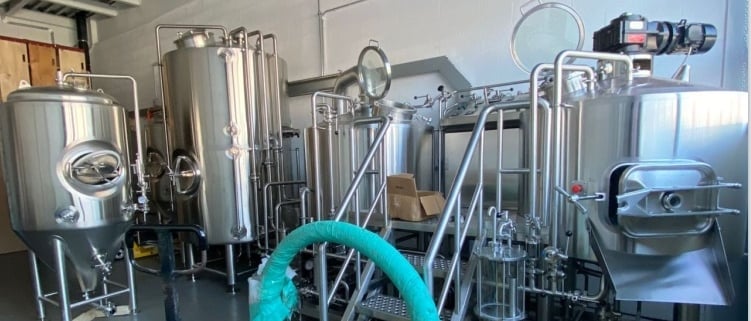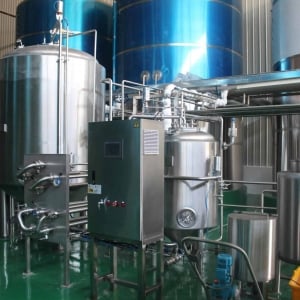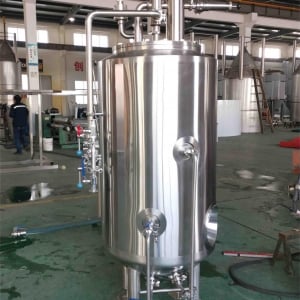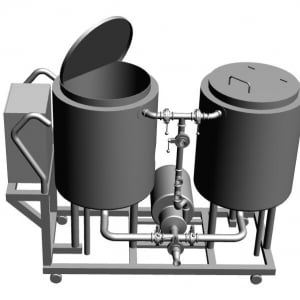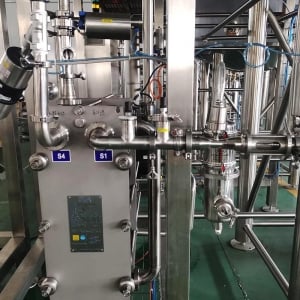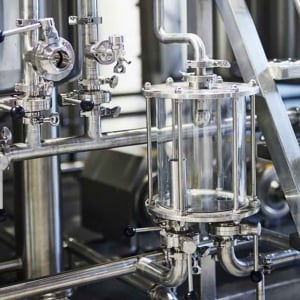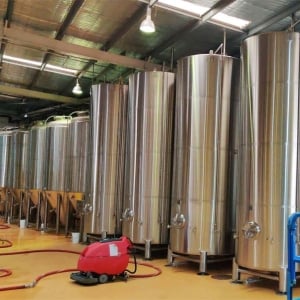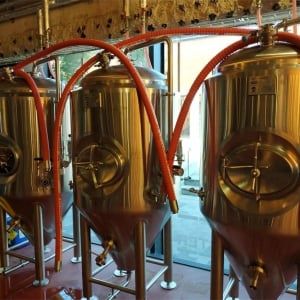Beer Fermenter Tanks
The heart of any brewing operation, from a passionate home hobbyist’s garage setup to a full-fledged production brewery, is the fermenter tank. This seemingly simple vessel is the stage where the magic happens – where your carefully crafted wort transforms into the delicious beer you crave. But beneath that stainless steel exterior lies a world of function and design that can significantly impact the quality and consistency of your final product.
This guide delves deep into the world of beer fermenter tanks, equipping you with the knowledge to choose the perfect vessel for your brewing needs. We’ll explore the different types of fermenters, the brewing process within them, key features to consider, and much more.
Types of Beer Fermenter Tanks: Choosing Your Brewing Companion
Just like there’s a beer style for every palate, there’s a fermenter tank for every brewing approach. Here’s a breakdown of the most common types:
| Fermenter Tank Type | Description | Ideal For |
|---|---|---|
| Unitanks (combined fermenters & brite tanks) | Multifunctional tanks that can handle both fermentation and conditioning in a single vessel. | Space-saving setups, breweries with limited floor space. |
| Cylindrical Conical Tanks (CCTs) | These workhorses feature a conical bottom that allows for easy collection of sediment (trub) during fermentation. | Wide range of beer styles, efficient yeast harvesting. |
| Lagertanks | Horizontally oriented tanks specifically designed for lagers, with features like jackets for temperature control during extended cold conditioning. | Lagers and other beers requiring precise temperature management. |
| Pressure Fermenters | Allow fermentation under pressure, enabling certain beer styles like cask ales and some wheat beers. | Experimentation with specific beer styles, adding carbonation during fermentation. |

Unveiling the Brewing Process: Inside the Fermenter Tank
Now that you’ve met the tank types, let’s peek inside and witness the wonder of fermentation. Here’s a simplified breakdown of the brewing process that unfolds within the fermenter:
- Transfer: After the wort has boiled and been separated from the hops in the brew kettle, it’s transferred to the fermenter tank. This sanitized vessel ensures a clean environment for yeast to work its magic.
- Pitching Yeast: The chosen yeast strain is introduced into the cooled wort. These tiny organisms are the rockstars of the show, consuming the wort’s sugars and producing alcohol and carbon dioxide – the hallmarks of beer.
- Fermentation: The yeast goes to work, transforming the sugary wort into beer. This process can take several days, depending on the yeast strain, beer style, and fermentation temperature. During this time, the CO2 produced creates a natural blanket over the beer, protecting it from spoilage.
- Conditioning: Once fermentation is complete, the beer enters a conditioning phase, where it matures and clarifies. This can involve secondary fermentation for certain styles or simply allowing the yeast to settle at low temperatures.
- Packaging (Optional): For homebrewers, bottling or kegging the finished beer is the final step. In commercial breweries, the beer is transferred to conditioning or serving tanks before final packaging.
Features of Beer Fermenter Tanks: Beyond Just a Container
While their core function remains the same, fermenter tanks come equipped with various features that can influence your brewing experience. Here are some key aspects to consider:
- Material: Stainless steel is the industry standard for its durability, ease of cleaning, and resistance to corrosion. Some homebrew tanks may be made of food-grade plastic, which is a more budget-friendly option but may not offer the same lifespan or heat transfer properties.
- Capacity: This refers to the volume of wort the tank can hold. Homebrew tanks typically range from 1 gallon to 5 gallons, while commercial breweries use tanks ranging from dozens to hundreds of barrels (a barrel equals 31 gallons). Consider your batch size and production goals when choosing a capacity.
- Jackets: A double-walled jacket allows for the circulation of coolant or heating water around the tank. This enables precise temperature control during fermentation, which is crucial for some beer styles.
- Pressure Rating: For brewers interested in pressure fermentation techniques, the tank needs to be rated to withstand the additional pressure.
- Valves and Fittings: These allow for transferring wort in and out of the tank, collecting yeast samples, and purging the tank with CO2 for sanitation.
- Monitoring Systems: Advanced tanks may include temperature gauges, pressure gauges, and even carbonation level monitors. These features provide valuable real-time data to ensure optimal fermentation conditions.
- Cleaning and Sanitation: Maintaining a clean and sanitary environment is paramount for successful brewing. Look for tanks with smooth, easy-to-clean surfaces and features like bottom drains for efficient trub removal.
- Aesthetics: While not the most critical factor, some brewers appreciate the sleek, professional look of stainless steel fermenters.
Cost Considerations: Beer Fermenter Tank Price Range
The price of a beer fermenter tank varies greatly depending on several factors, including:
- Size: Larger tanks naturally cost more than smaller ones.
- Material: Stainless steel tanks are more expensive than plastic tanks.
- Features: Tanks with features like jackets, pressure ratings, and monitoring systems will command a higher price tag.
- Brand: Reputable brewing equipment manufacturers may charge a premium for their products.
Here’s a table outlining a general price range for different types and sizes of beer fermenter tanks:
| Fermenter Tank Type | Size (Gallons) | Price Range (USD) |
|---|---|---|
| Homebrew Bucket Fermenters (Plastic) | 1-5 | $50 – $200 |
| Homebrew Conical Fermenters (Stainless Steel) | 5-15 | $200 – $1000 |
| Unitanks (Small Scale) | 15-50 | $2000 – $5000 |
| Cylindrical Conical Tanks (CCTs) | 50-500 | $5000 – $20,000+ |
| Lagertanks | 100+ | $10,000+ |
Remember: These are ballpark figures, and the actual cost can vary depending on the specific features and brand you choose.
Installation, Operation, and Maintenance: Keeping Your Fermenter Tank Running Smoothly
Once you’ve selected your ideal fermenter tank, it’s time to set it up for use. Here’s a basic overview of the process:
- Installation: For larger tanks, professional installation is recommended to ensure proper placement and connection to utilities. Homebrew tanks may require minimal setup, such as attaching valves and ensuring proper positioning.
- Operation: Operating a fermenter tank involves maintaining temperature control (if your tank has a jacket), monitoring fermentation progress, and transferring the beer for conditioning or packaging at the appropriate time. Consulting your chosen brewing recipe and equipment instructions will provide specific details.
- Maintenance: Regular cleaning and sanitation are crucial for maintaining the lifespan and performance of your fermenter tank. After each use, the tank should be thoroughly cleaned with a hot water and sanitizer solution.
Choosing the Right Supplier: Finding Your Brewing Partner
With a vast array of fermenter tank options on the market, selecting the right supplier is vital. Here are some key factors to consider:
- Reputation: Research the supplier’s reputation for quality products, customer service, and technical support. Reading online reviews and checking industry forums can be helpful.
- Product Range: Ensure the supplier offers a variety of tanks that cater to your specific needs and budget.
- Warranty and Support: A solid warranty and reliable customer support are valuable assets in case of any issues with your tank.
- Price: Compare prices from multiple suppliers while considering the overall value proposition, including features, warranty, and customer service.
Beer Fermenter Tanks – A Balanced View
Pros:
- Essential for Fermentation: Fermenter tanks are the workhorses of the brewing process, providing a controlled environment for yeast to transform wort into beer.
- Improved Beer Quality: Proper temperature control and features like conical bottoms for easy trub removal can significantly enhance the quality and consistency of your brews.
- Scalability: Fermenter tanks come in a wide range of sizes, allowing you to scale your brewing operation from homebrew batches to full-scale production.
- Versatility: Certain tank types, like unitanks, offer multi-functionality, reducing the need for separate fermentation and conditioning vessels.
Cons:
- Cost: Fermenter tanks, particularly larger commercial models, can be a significant investment.
- Space Requirements: Larger tanks require dedicated space, which may be a constraint for homebrewers or breweries with limited floor space.
- Cleaning and Maintenance: Maintaining proper sanitation requires time and effort.
- Complexity: Operating advanced tanks with features like jackets and monitoring systems may have a steeper learning curve.
- Monitoring Systems: Advanced tanks may include temperature gauges, pressure gauges, and even carbonation level monitors. These features provide valuable real-time data to ensure optimal fermentation conditions.
- Cleaning and Sanitation: Maintaining a clean and sanitary environment is paramount for successful brewing. Look for tanks with smooth, easy-to-clean surfaces and features like bottom drains for efficient trub removal.
- Aesthetics: While not the most critical factor, some brewers appreciate the sleek, professional look of stainless steel fermenters.
Cost Considerations: Beer Fermenter Tank Price Range
The price of a beer fermenter tank varies greatly depending on several factors, including:
- Size: Larger tanks naturally cost more than smaller ones.
- Material: Stainless steel tanks are more expensive than plastic tanks.
- Features: Tanks with features like jackets, pressure ratings, and monitoring systems will command a higher price tag.
- Brand: Reputable brewing equipment manufacturers may charge a premium for their products.
Here’s a table outlining a general price range for different types and sizes of beer fermenter tanks:
| Fermenter Tank Type | Size (Gallons) | Price Range (USD) |
|---|---|---|
| Homebrew Bucket Fermenters (Plastic) | 1-5 | $50 – $200 |
| Homebrew Conical Fermenters (Stainless Steel) | 5-15 | $200 – $1000 |
| Unitanks (Small Scale) | 15-50 | $2000 – $5000 |
| Cylindrical Conical Tanks (CCTs) | 50-500 | $5000 – $20,000+ |
| Lagertanks | 100+ | $10,000+ |
Remember: These are ballpark figures, and the actual cost can vary depending on the specific features and brand you choose.
Installation, Operation, and Maintenance: Keeping Your Fermenter Tank Running Smoothly
Once you’ve selected your ideal fermenter tank, it’s time to set it up for use. Here’s a basic overview of the process:
- Installation: For larger tanks, professional installation is recommended to ensure proper placement and connection to utilities. Homebrew tanks may require minimal setup, such as attaching valves and ensuring proper positioning.
- Operation: Operating a fermenter tank involves maintaining temperature control (if your tank has a jacket), monitoring fermentation progress, and transferring the beer for conditioning or packaging at the appropriate time. Consulting your chosen brewing recipe and equipment instructions will provide specific details.
- Maintenance: Regular cleaning and sanitation are crucial for maintaining the lifespan and performance of your fermenter tank. After each use, the tank should be thoroughly cleaned with a hot water and sanitizer solution.
Choosing the Right Supplier: Finding Your Brewing Partner
With a vast array of fermenter tank options on the market, selecting the right supplier is vital. Here are some key factors to consider:
- Reputation: Research the supplier’s reputation for quality products, customer service, and technical support. Reading online reviews and checking industry forums can be helpful.
- Product Range: Ensure the supplier offers a variety of tanks that cater to your specific needs and budget.
- Warranty and Support: A solid warranty and reliable customer support are valuable assets in case of any issues with your tank.
- Price: Compare prices from multiple suppliers while considering the overall value proposition, including features, warranty, and customer service.
Weighing the Pros and Cons: Beer Fermenter Tanks – A Balanced View
Pros:
- Essential for Fermentation: Fermenter tanks are the workhorses of the brewing process, providing a controlled environment for yeast to transform wort into beer.
- Improved Beer Quality: Proper temperature control and features like conical bottoms for easy trub removal can significantly enhance the quality and consistency of your brews.
- Scalability: Fermenter tanks come in a wide range of sizes, allowing you to scale your brewing operation from homebrew batches to full-scale production.
- Versatility: Certain tank types, like unitanks, offer multi-functionality, reducing the need for separate fermentation and conditioning vessels.
Cons:
- Cost: Fermenter tanks, particularly larger commercial models, can be a significant investment.
- Space Requirements: Larger tanks require dedicated space, which may be a constraint for homebrewers or breweries with limited floor space.
- Cleaning and Maintenance: Maintaining proper sanitation requires time and effort.
- Complexity: Operating advanced tanks with features like jackets and monitoring systems may have a steeper learning curve.
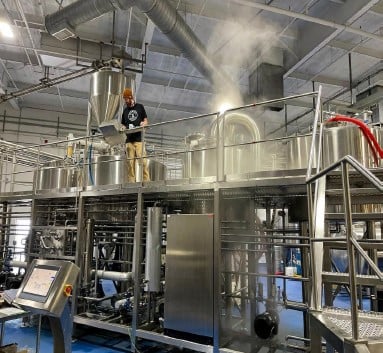
FAQ
If you’re new to the world of beer fermenter tanks, you might have some lingering questions. Here’s a FAQ section to shed light on some common inquiries:
Q: Can I use a plastic bucket as a fermenter tank?
A: While technically possible for homebrewing small batches, plastic buckets have limitations. They are prone to scratches and harboring bacteria, making them more challenging to clean and sanitize properly. Stainless steel fermenters offer superior durability, ease of cleaning, and temperature control.
Q: What size fermenter tank do I need?
A: This depends on your batch size and brewing goals. Homebrewers typically start with 1-gallon to 5-gallon tanks. For commercial breweries, the size depends on production volume. Consider factors like the number of batches you plan to brew per week and the desired finished product volume.
Q: Do I need a jacketed fermenter tank?
A: Jackets are essential for precise temperature control during fermentation, which is crucial for some beer styles like lagers. If you plan to brew a variety of styles or experiment with temperature-sensitive yeasts, a jacketed tank is a worthwhile investment. However, for basic ale brewing at room temperature, a non-jacketed tank might suffice.
Q: How do I clean and maintain my fermenter tank?
A: After each use, thoroughly clean your tank with a hot water and sanitizer solution. Pay attention to fittings and valves, ensuring no wort or yeast residue remains. Regularly inspect your tank for signs of wear or damage. Following the manufacturer’s cleaning and maintenance recommendations is essential.
Q: Where can I find resources to learn more about fermenter tanks?
A: Numerous online resources cater to brewers of all experience levels. Homebrew forums, online communities, and educational websites from reputable brewing equipment suppliers offer valuable information on fermenter tanks and the brewing process.
By understanding the different types of beer fermenter tanks, their features, and the factors to consider when choosing one, you’ll be well-equipped to select the perfect vessel for your brewing adventures. Remember, the right fermenter tank can significantly elevate the quality and consistency of your homebrews or commercial beer production. Whether you’re a passionate homebrewer or an aspiring brewery owner, selecting the ideal fermenter tank is a crucial step on your brewing journey.

